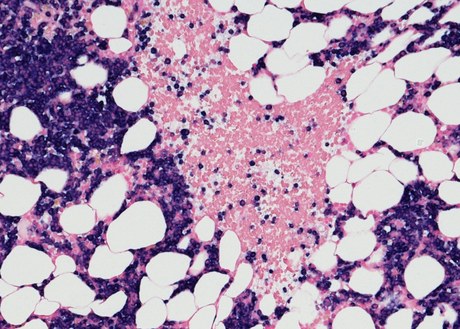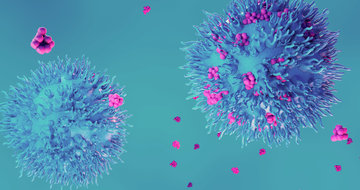Elrexfio (Elranatamab-bcmm) for relapsed or refractory multiple myeloma after at least four prior lines of therapy including an immunomodulatory agent, proteasome inhibitor, and anti-CD38 antibody. The corresponding FDA website for this is: Accelerated approval for Elranatamab-BCCM for Multiple Myeloma
What is the potential role of elranatamab-bcmm in the treatment of multiple myeloma?
- Elranatamab is a humanized bispecific antibody that binds B Cell maturation antigen (BCMA) on myeloma cells and CD3 on T-cells, leading to death of the BCMA-expressing cells.1
- Elranatamab is approved for patients with relapsed or refractory multiple myeloma that has progressed on at least four lines of therapy as noted above. Approval was based on data collected in the single-arm, phase 2 MagnetisMM-3 trial, which is ongoing.
- MagnetisMM-3 included 123 adult patients with multiple myeloma refractory after receiving at least one therapy (a proteasome inhibitor, immunomodulatory, or an anti-CD38 antibody).2 Patients in this cohort had not received prior BCMA-directed therapy.
- The primary endpoint was the objective rate response (ORR)
- Key secondary endpoints included median progression free survival (PFS) and overall survival (OS)
- Responses occurred in 61% of patients; 56.1% of responses were considered very good partial responses and 35% of responses were considered complete responses.
- The median time for the first response was 1.2 months (range, 0.6-7.7 month), and median time for the best response was 1.2 months (range, 1.2-14.3 month)
- Response rates were generally lower in patients with extramedullary disease, stage III disease, and at least 60% marrow replacement by plasma cells. Patients who had received no more than four lines of previous therapy were more likely to respond to elranatamab.
- Fifty patients received biweekly dosing; 80% of these improved or maintained their response for at least 6 months.
- At a median follow-up of 14.7 months, the key secondary endpoints of median PFS and OS were not reached.
- Safety
- Adverse effects were reported in all patients in this trial; grade 3/4 were reported in 70.7%.
- Cytokine Release Syndrome (CRS) occurred in 56.3% of the patients; all were Grade 1 or 2
- Immune effector cell-associated neurotoxicity syndrome (ICANs) occurs in 3.4% of the patients with only Grade 1 and 2 adverse events reported.
- Infections occurred in 69.9% of the population, 39.8% had a Grade 3 or greater, and 6.5% had a fatal infection.2
- Peripheral Neuropathy was reported in 17.1% of patients as “motor dysfunction” and in 13.8% of patients as “sensory neuropathy”.
- Hematological adverse effects such as neutropenia, anemia, thrombocytopenia and lymphopenia had occurred in patients. These were grade 3/4 in over 30% of patients. Approximately 40% of patients experienced a dosage delay due to hematological AEs.2
- As of this writing, both elranatamab and teclistamab are potential treatment options for patients with relapsed/refractory myeloma after at least four prior lines of treatment.3 While inter-trial comparisons have inherent limitations, overall the response rates appear to be similar (ORR 61% with elranatamab v ORR 61.8% with teclistamab) in patients with multiple myeloma after at least 3 prior lines of therapy.2,5 Teclistamab had a reported median PFS of 11.3 months, while this is not yet mature with elranatamab. Grade 3/4 adverse effects were reported in 70.7% of patients receiving elranatamab on trial v 94.5% of patients in the teclistamab trial. Decreased appetite may be more common with elranatamab while CRS and ICANS may be slightly more common with teclistamab, although this is difficult to note with certainty as the two agents have not been compared head-to-head in a randomized trial.6 Specific product selection will be impacted by multiple factors including patient specific factors, provider and institutional preferences, toxicity profile, duration of therapy/schedule of administration and cost.
What role can the pharmacist play in the management of patients on elranatamab-bcmm?
- Elranatamab is given as a subcutaneous injection, as follows:
- Step-Up dosing: elranatamab is 12 mg subcutaneously on Day 1, 32 mg subcutaneously on Day 4, and 76 mg on Day 8
- Subsequent dosing is 76 mg subcutaneously weekly for weeks 3-24.
- At week 25, patients may receive 76 mg subcutaneously every other week until disease progression or unacceptable toxicity.
- Premedication of acetaminophen 650 mg PO, dexamethasone (or equivalent) 20 mg PO/IV, and diphenhydramine (or equivalent) 25 mg PO should be given an hour before the administration to elranatamab in the step-up dosing schedule which includes the step-up dose 1, step-up dose 2, and the first treatment dose on day 8 as prescribed.
- There are no dose reductions for toxicity, but dosage delays may be necessary
- Elranatamab can release cytokines that may be able to suppress the activities of Cytochrome P450 enzymes. It is best to monitor for toxicity and drug concentration when elranatamab is co-administered with any CYP substrates.
- Since elranatamab can cause life-threatening adverse effects such as CRS or neurological problems, it is essential to recognize the early signs of CRS and neurological toxicities.
Clinical Pearls
- Step-up dosing is required when initiating elranatamab for relapsed or refractory multiple myeloma. After completion of step-up dosing, a minimum of 6 days should be maintained between doses.1
- Syringes can be stored between 2 °C (36 °F) to 30 °C (86 °F) for a maximum of 4 hours if not intended for immediate use.
- It is important to note that patients should not drive or operate any heavy machinery 48 hours after administering elranatamab to the patient.
- Due to the risk of CRS and ICANs, the FDA requires a Risk Evaluation and Mitigation Strategy (REMS), available at Elrexfio REMS 7
- For financial and co-payment assistance program for elranatamab, patient can be enrolled in the Patient Access Navigator program through the Pfizer Oncology Together program to be assisted on out-of-pocket costs, available at Elrexfio Financial Support 8
References
- Elrexfio (Elranatamab) [package insert]. New York, NY:Pfizer Labs 2022.
- Lesokhin, A.M., Tomasson, M.H., Arnulf, B. et al. Elranatamab in relapsed or refractory multiple myeloma: phase 2 MagnetisMM-3 trial results. Nat Med 29, 2259–2267 (2023). https://doi.org/10.1038/s41591-023-02528-9
- National Comprehensive Cancer Network. Multiple Myeloma (Version 1. 2024). Accessed October 16, 2023. https://www.nccn.org/professionals/physician_gls/pdf/myeloma.pdf.
- Tecvayli (Teclistamab) [package insert]. Beerse, Belgium: Janssen Pharmaceuticals; 2022.
- Moreau P, Garfall AL, van de Donk NWCJ, et al. Teclistamab in relapsed or refractory multiple myeloma. N Engl J Med 2022; 387:495-505.
- Helwick C. Expert Point of View: Urvi A. Shah, MD. January 25, 2023. Accessed October 22, 2023. https://ascopost.com/issues/january-25-2023/epov-urvi-shah/
- Elrexfio Risk Evaluation and Mitigation Strategy (REMS). Accessed October 18, 2023. https://www.elrexfiorems.com/#Main.
- Elrexfio Navigating Support Financial Resources. Accessed October 18, 2023. https://www.elrexfio.com/navigating-support-financial-resource



